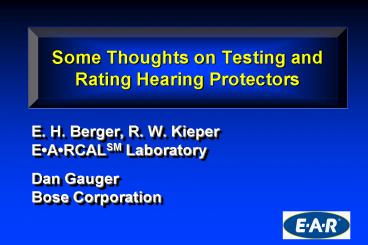E. H. Berger, R. W. Kieper - PowerPoint PPT Presentation
1 / 29
Title:
E. H. Berger, R. W. Kieper
Description:
Some Thoughts on Testing and Rating Hearing Protectors. Issues in Estimating User Protection ... Compute ratings from the use of true distributions vs. use of ... – PowerPoint PPT presentation
Number of Views:103
Avg rating:3.0/5.0
Title: E. H. Berger, R. W. Kieper
1
Some Thoughts on Testing and Rating Hearing
Protectors
- E. H. Berger, R. W. Kieper
- EARCALSM Laboratory
- Dan Gauger
- Bose Corporation
2
Issues in Estimating User Protection
- Accurate noise exposure estimates
- Valid HPD attenuation data
- Suitable computational scheme
3
Noise Measurement Variability
- SLM accuracy with calibrator 0.2 dB
- Microphone frequency response(Type 1) 1 to
1.5 dB - Sampling accuracy 2 to 2.5 dBA
- For 95 confidence of sampling worker with
exposure in top 20 of the group N 12, must
sample 8 personnel N 50, must sample 12
personnel
4
Military Transport
UH-60 Helicopter
5
(No Transcript)
6
Real-World Studies
- 22 studies, gt90 industries (3 military), 7
countries, 3000 subjects (Argentina, Canada,
Finland, Germany, Netherlands, UK and US) - In all cases employees/soldiers were wearing
their own hearing protection in the way normally
utilized - These programs represent best possible hearing
conservation programs (HCPs)
7
(No Transcript)
8
(No Transcript)
9
Effects of Wearing Time
30
Assigned NRR
25
25
20
20
Time-Corrected NRR (dB)
15
15
10
10
5
5
Minutes not worn
240 120 60 30 10
5 2.5 0.5
0
Percentage Time Worn
10
Computational Issues
- What noise data do we use for our evaluation?
- Octave Band Computation How gold is our gold
standard?
11
(No Transcript)
12
(No Transcript)
13
Multiple-Number Ratings
- Sound Level Conversion (Botsford 1973)
- dBA Reduction (Waugh, 1973)
- 2-Number Method (Johnson and Nixon, 1974)
- HML (Lundin, 1980)
14
Single-Number Ratings
- C to A (Botsford type) SLC80, Z, NRR, and SNR
- A to A (constant protection) R, NRR(SF)
15
A Weighting
Summation Curve
Typical Earmuff
16
Performance of earmuff in two extreme spectra
C - A 11
C - A -1
11
dBA 103
15
dBA 92
24
38
35
11
15
24
34
30
34
30
35
dBA 70
38
A - A 33 dB
A - A 18 dB
dBA 74
17
ANSI S12/WG11Hearing Protector Attenuation and
Performance
- There is not now and never has been an ANSI
standard for computing attenuation - NRR is defined in EPA regulation, based upon
NIOSH proposal
18
Preliminary Results of Ongoing Analyses
- Waugh (1976 and 1984)
- Sutton and Robinson (1981)
- Key Features of our analysis Use OB method as
the gold standard Compute error distribution
for individual-subject data
19
The Input Data
- 100 NIOSH noises
- S12.6-1997 Method-B Data for 10 earplugs (1 flat
attenuation)9 earmuffs (1 flat attenuation)1
dual combination
20
Computing Procedure
Attenuation of 20 HPDs for individual subjects
Octave - band SPLS for 100 NIOSH noises
Estimate A using rating and selected noise
spectrum
Shift spectrum so estimated A 85 dBA
Repeat for each spectrum
Repeat for each protector
Compute actual A using OB method for each
subject in shifted spectrum
Compute statistics of actual A distributions
21
(No Transcript)
22
20 HPDs Plugs Muffs
79 dB 7.6 dB 82
81 dB 4.8 dB 83
78 dB 8.5 dB 81
OB
80 dB 7.8 dB 78
82 dB 5.3 dB 78
78 dB 8.6 dB 78
NRFC
80 dB 8.8 dB 70
80 dB 8.8 dB 70
83 dB 6.0 dB 64
NRFA
23
Remaining Questions
- Compute ratings from the use of true
distributions vs. use of normal statistics - Examine other ratings
- HML
- Hi-Lo Range
- Class/Grading Scheme
- Select best method to present the data
24
Observations
- Be aware that variability exists in all aspects
of HPD estimation noise measurement, attenuation
measurement, and the computational approach. - Best predictor of field performance for groups of
workers/soldiers is Method B. - In an extreme spectrum, if you know attenuation
and OB levels of the noise, OB will be most
accurate. - Because of wearer variability, single-number
ratings are simple suitable alternatives to the
OB method for general noise exposures. - When overprotection is not a concern (crew
w/helmets and built-in communications systems)
select HPDs for sufficient protection in the
worst-case noise exposure.
25
(No Transcript)
26
Distribution of Helicopter Noise
27
(No Transcript)
28
Summary Statistics
29
Dual































